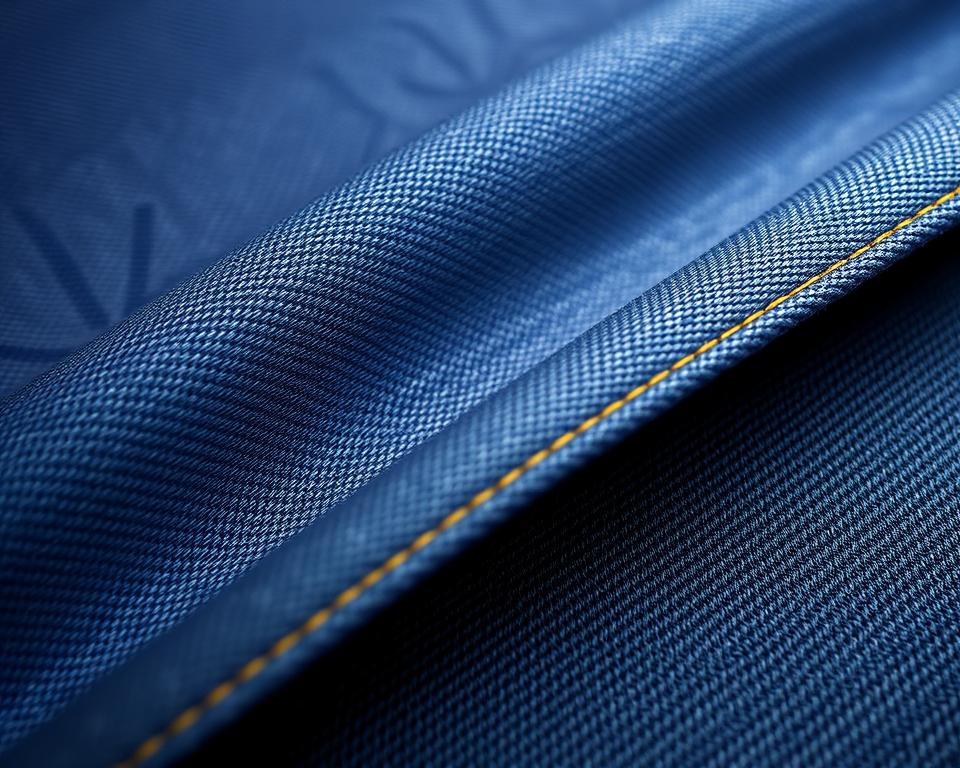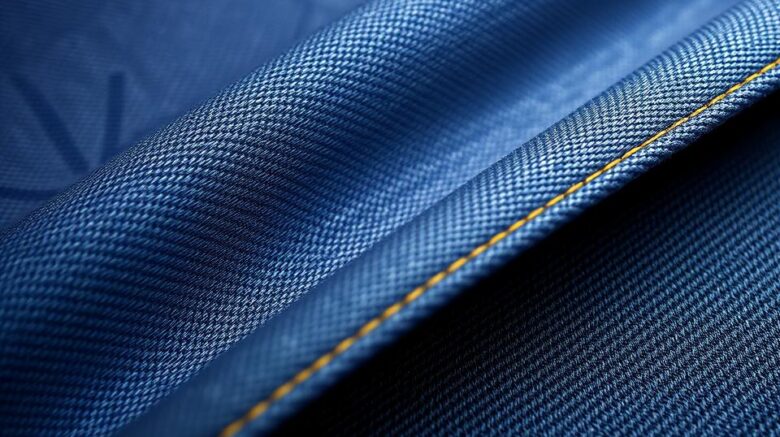The Ultimate Manual for Superior denim Edge-to-Edge Fabric
Have you ever wondered why some pants seem like they’re designed for longevity the ages? The secret lies in the materials and skill. Take, for instance, the growing movement of high-end selvedge. This goes beyond common material—it exemplifies superiority and legacy.
Nowadays, increasingly more individuals are choosing these timeless textiles for their sturdiness and traditional selvedge denim fabric allure. Be it that you are a DIY sewist or a denim aficionado, there’s an exceptional aspect about working with superior cotton and stitching. It isn’t solely concerned with making pants; it centers on producing a legacy.
At Core Fabrics, we’ve selected a range of 14.25oz eco-friendly cotton and stretch options. Such textiles are ideal for all from raw jeans to couture jacket designs. Eager to discover the realm of exceptional fabrics? Let us delve in.
What Is Denim Selvedge Fabric?
Why do some trousers stand out with their unique, self-finished seams? The answer lies in the selvedge denim, a superior textile known for its enduring strength and vintage aesthetic. In contrast to conventional textiles, such material is crafted using traditional methods that have endured through ages.
The Definition of Selvedge Denim
Selvedge denim is produced using retro shuttle looms, which produce narrow widths of about 30-35 inches. They intertwine the fabric in a manner that ensures self-finished borders, often accented with a characteristic red line. This process ensures the fabric is densely interlaced and extremely robust.
Modern looms, in contrast, yield wider textile but fall short of the equivalent of skill. Subtle irregularities in selvedge, like leg twists or uneven textures, are embraced as features of its character. This philosophy, often referred to as “wabi-sabi”, celebrates the aesthetic of organic flaws.
The Making of Selvedge Denim
The production of selvedge denim entails a detailed process. Traditional shuttle looms interlace the weft thread alternately, creating a compact and resilient fabric. This process stands in contrast with contemporary machines, which focus on rapid output over quality.
Companies such as Karson Denim preserve traditional Japanese methods from the nineteen-nineties. They deliberately incorporate imperfections to maintain the genuineness of the material. Each piece is graded on a 4-point system, confirming it fulfills the highest standards of quality.
| Attribute | Selvedge Denim | Modern Denim |
|---|---|---|
| Span | 30-35 inches | 60+ inches |
| Construction Technique | Classic Shuttle Loom | Contemporary Loom |
| Surface | Non-uniform, Raw | Even |
| Sturdiness | Superior | Average |
“The charm of selvedge lies in its imperfections—each flaw tells a story craftsmanship and tradition.”
The History of Selvedge Denim
Evolving from simple roots to global acclaim, the narrative of these materials is vibrant and motivational. What started as durable workwear in seventeenth-century France has become a mark of timeless style and craftsmanship.
Origins in Traditional Weaving
The roots of this textile dates back to Nîmes, France, where it was referred to as “serge de Nîmes.” First intended for workers, it was made from robust cotton and thread. Its strength made it a favorite among workers during the historic Gold Rush.
During the twentieth century, it had become a essential element for trousers. The shuttering of the Cone Mills White Oak plant marked a turning point. This transition enabled Japanese craftsmen to reintroduce old-world weaving methods.

Advancements in Production
Post-WWII, Japan embraced retro American culture. Craftsmen restored classic looms to manufacture authentic reproductions. This devotion to craftsmanship ensured the survival of selvedge as a unique product.
In modern times, advancements from Italy and Turkey have introduced sustainable mixtures and flexible selections. These improvements have widened the attraction of this timeless material. At Core Fabrics, we procure internationally, from Montréal to Asia, to deliver to you the finest standards.
“The history of selvedge is a testament to the lasting worth of craftsmanship and legacy.”
Reasons to Select Selvedge Denim?
What makes selvedge denim stand out in the realm of superior textiles? Its distinct attributes and incomparable robustness have made it beloved among lovers and stylists alike. Be it that you are making jeans or a tailored jacket, this textile offers a mix of tradition and updated style.
Distinctive Attributes of Selvedge
Selvedge denim is celebrated for its tight weave, which boosts ripping resistance and fade potential. Unlike standard materials, rainbow selvedge denim is fashioned using classic shuttle looms, yielding a more compact and extra robust material. In doing so, it secures that every item possesses a singular finish and character.
Key features include:
- Textured, firm raw denim offers a contrast to softened, pre-washed stretch fabrics.
- Sanforization stabilizes the fabric for consistent measurements, while untreated fabrics provide a shrink-to-fit adventure.
- Weight options range from 9.5oz Eco Finish to 14.25oz Organic, meeting diverse applications.
Sturdiness and Lifespan
One of the key attributes of selvedge denim is its long life. The dense fabric structure boosts robustness while enabling unique fading patterns over time. This renders it a treasured choice for those looking for classic garments.
Key points to consider:
- Mid-weight fabrics from 12oz to 14oz work well for tailored jackets and evolving jeans.
- Opt for the 14.25oz True Indigo for traditional jean lifespan.
- Eco-friendly options, like recycled cotton and indigo blends, add sustainability to your wardrobe.
At Core Fabrics, our collection includes a variety of options to suit your needs. Whether untreated or sanforized, every item is made to provide outstanding quality and performance.
Selvedge Denim vs. Wide Denim
For making long-lasting and trendy pieces, the choice of material is pivotal. Two common choices include selvedge and wide denim, both offering different features. Comprehending their variances guides the right one for your endeavor.
Key Differences in Weaving Techniques
Selvedge denim is crafted with classic shuttle looms, resulting in limited spans of 30-35 inches. This herringbone denim material technique generates secure finishes, often marked by a characteristic red line. In contrast, wide denim is produced using modern projectile looms, yielding expansive widths of over 60 inches.
Shuttle looms are slower, producing about 3 meters per minute, while modern projectile looms reach speeds of 30 meters per minute. The variance in production speed affects both the expense and the texture of the outcome.
Benefits and Drawbacks
Selvedge denim is known for its premium quality and durability. Its narrow width makes it ideal for creations where visible hems or patches are desired. However, it can be costlier, typically around $23 per meter.
Wide denim is more cost-effective, typically costing $8 per half-meter. Its wider width reduces waste, well-suited to extensive endeavors like furniture covering. However, it lacks the unique edge finish of selvedge.
| Characteristic | Selvedge Denim | Wide Denim |
|---|---|---|
| Span | 30-35 inches | 60+ inches |
| Method | Traditional Shuttle | Contemporary Projectile Loom |
| Production Speed | 3m per minute | 30 meters per minute |
| Cost | $23/meter | $8/half-meter |
For structured edges, like those needed in Grainline Thayer jackets, selvedge is the preferred choice. In contrast, wide denim provides cost-effectiveness and speedy production. Weigh your requirements carefully to decide.
Maximizing Your Selvedge Denim
Utilizing superior fabrics can transform your sewing endeavors. Whether you’re crafting pants, blazers, or frocks, grasping fabric quantities, proper sewing methods, and maintenance guarantees a polished result. We will examine the optimal use of this everlasting textile.
Material Requirements for Jeans and Jackets
When planning your project, calculating the right amount of material is crucial. For men’s jeans, you’ll need about 3-3.3 yards, accounting for potential defects and shrinkage. For trucker jackets, expect to use around 3.3 yards, while skirts can be made with just 2 yards.
Creative pattern placement can help manage imperfections in the material. Embrace the natural defects by weaving them into your creative design.
| Project | Yardage Needed |
|---|---|
| Male Jeans | 3-3.3 yards |
| Trucker Jacket | 3.3 yards |
| Dress | 2 yards |
Advice for Sewing and Longevity
Using the right tools and techniques ensures a polished result. Choose #70-110 needle sizes and machine attachments made for robust textiles. Gütermann rPET thread works well for contrasting stitches.
Additional advice includes:
- Use a tailor’s clapper for sharp creases without shine.
- Core Fabrics’ denim kits include topstitch thread, rivets, and 9mm jeans buttons for a professional finish.
- For structured edges, like those in jackets, selvedge is the preferred choice.
Maintaining your pieces properly increases their longevity. Wash sparingly and air dry to maintain the material’s integrity. Following these guidelines guarantees enduring results.
The Final Word
Crafting with premium materials isn’t just about durability—it’s about creating something with character. Selvedge denim embodies this principle, merging handcrafted appeal with long-lasting quality. Be it crafting jeans or tailoring a refined jacket, each stitch narrates a tale.
Core Fabrics simplifies your creative journey. Experience our swatch service to gauge texture and weight prior to purchase. Plus, enjoy free shipping on orders over $150 USD across North America.
Looking ahead, eco-friendly blends and vintage washes are shaping the future of cotton textiles. They open fresh avenues for merging sustainability with chic style.
Prepared to immerse yourself in superior fabrics? Begin your journey now and appreciate the merit of intentional crafting. Your subsequent creation may well become an enduring classic.
